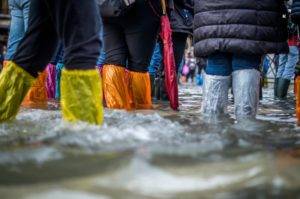Floods are the most common natural hazard in Canada and can occur at any time of the year.
Any resident living near a massive body of water such as a river or lake should be aware of the signs of flooding. The Old Farmer’s Almanac explains how to predict if a flash flood is coming near you:
- Flash Floods, which are characteristics by extremely fast and rapidly rising waters, occur within six hours of a rain event.
- A huge indicator of a flood is when you notice the ground becoming oversaturated with water.
- On the outside, it often looks like there’s a pond or lake growing where it shouldn’t be. Another sign of a flood is if you see a slow moving storm pass through the same area you’re in.
- If you notice the rain beating down at an abnormally fast pace, the odds of a flood are very high. Floods can occur from the following:
- Winter snow thawing in the Spring
- Heavy rains caused by thunderstorms
- Moist air that rapidly rises
- Tropical storms and hurricanes from eastern Canada
Reacting to Flash Floods

Residents living in an urban landscape should expect water congestion in the streets and near buildings.
Despite the amount of sewers that scatter across the roads, if a heavy rain is beating down faster than the sewers can manage, it can cause a halt in traffic and water to accumulate across the roads surface.
Driving in these conditions can be dangerous.
If you’re driving home and get caught in a flood, it’s best to stop your car in an area where the flood hasn’t touched and wait the storm out.
Checking the weather ahead of time can help you plan your commute and avoid getting caught in a flood.
Protecting against flash flooding

Serious cases of floods can result in damage to personal property and even power outages.
Utilizing various flood barriers, like Hesco Barriers and Quik-Response Sandless Sandbags by Vasalta are a great way to protect your home from flooding.
Rocks, uprooted trees and debris can cause serious damage to your home when a flood is strong enough to move them from their initial placement.
In severe cases, the outcome of a flood can create mold in areas that were impacted by it.
To avoid putting yourself at risk during a flood, make sure to stay out of flowing water, protect your property and take safety precautions to protect your friends and family! Both during and after the flood, avoid contact with floodwater, even if you think it doesn’t look deep. The reason for this is because it only takes 6 inches of moving water to make an agile person lose their balance.

